Consumed with photographing grebes swimming in glassy water, my excitement level was elevated after just finding a ‘rare in the area’ Clark’s Grebe that provided a couple nice images that rank above documentary. Eared Grebes, Western Grebes, and a lone Horned Grebe – all at close quarters – grabbed my photo attention as I idled down the lane that divided the main water body at Long Lake National Wildlife Refuge. But suddenly I spied a small whitish bird scrambling ahead of me. What? WoW! I certainly didn’t have a Piping Plover on my radar last Wednesday, but there it was, close!
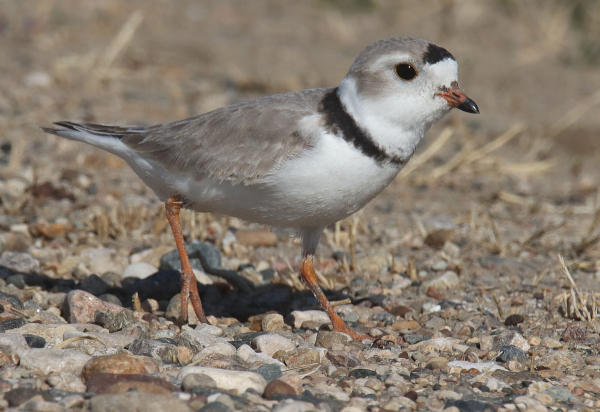
Surprise, Surprise – a Piping Plover! The camera settings were the same for every photograph of the plover: Paul zoomed his lens to 550mm after selecting an f-8 aperture, which provided a 1/2500 shutter speed using the Av (aperture priority) Mode setting and an ISO of 400).
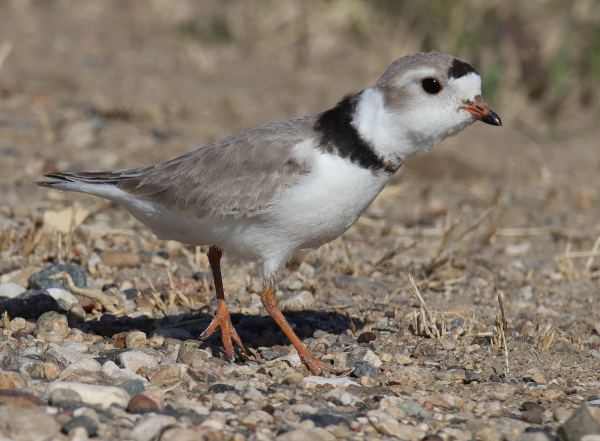
A moment after taking the first photo above, the plover stretched its neck forward, providing an interesting view of its extended neck ring. It was probably showing a bit of concern, but only because it was walking ever-closer before it continued past Paul’s mobile blind.
I checked the exceptional shorebird’s behavior with binoculars and held my breath lest it might react unfavorably to my presence – that is the presence of my car, my mobile blind. It was the peak good lighting period on that sunny, mostly windless late afternoon, but the Piping Plover was located between me and the sun – an impossible photo situation for me. I needed to be on the opposite side of this rare bird. What were my options?
That’s when I realized a big truck pulling a cattle trailer was closing in behind me, the only vehicle I had seen during my time at the refuge, and its legal access to the narrow refuge road was highly questionable. Nonetheless, I could tell it was not going to stop for anything, much less me or the tiny plover, so I inched to the edge of the water and hoped I might prosper when the plover repositioned – perhaps circling behind me? The truck and trailer barreled by, flushing the plover, although it didn’t seem too alarmed and I had the feeling it wouldn’t fly far, so followed its flight through binoculars so I wouldn’t lose sight of it.
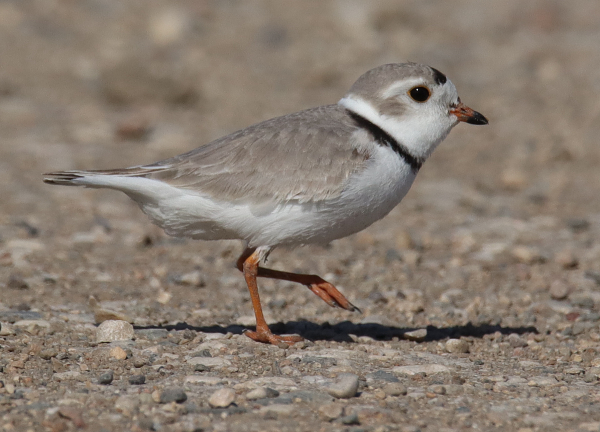
A classic image of a Piping Plover scurrying across an open area is exemplary of how the plover was not only accepting but also accommodating, providing a variety of photo options.
Ah, it landed 20 yards ahead at a point where there was a little more of a shoulder on each side of the road. After letting the Piping Plover settle in and begin foraging a minute or so, I began inching forward and got the impression that I might be able to ease past the plover, thereby getting on the other side of the bird where the afternoon sunlight would provide perfect lighting for photos. I crossed my fingers, held my breath, and although I was ready to stop my progress if I perceived any distress from the plover, it stayed on one shoulder of the narrow road, and I gingerly passed by it on the other shoulder. It worked! What Luck!
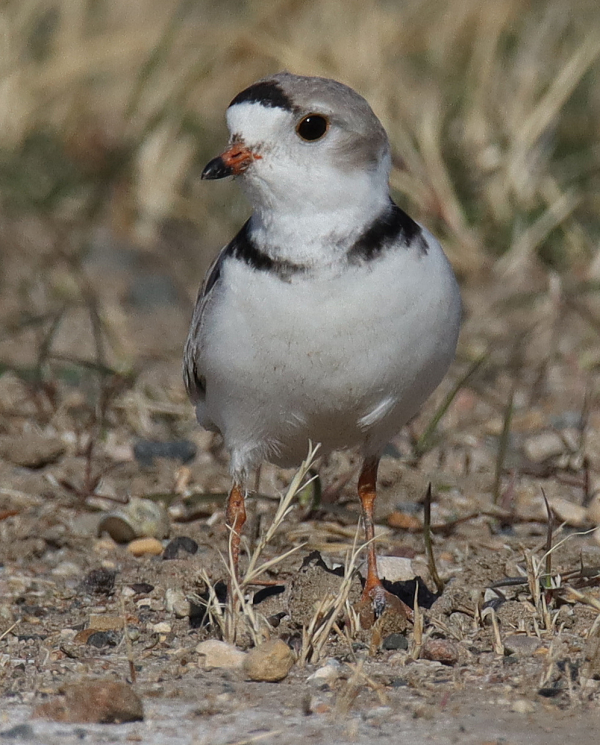
A front view of the Piping Plover, similar to the original view of the bird when first discovered. But getting to the opposite side of the bird where the sunlight provided the most accurate coloration seemed to be an unlikely possibility at first.
|
About 50 feet on down the road I turned my car sideways since there was no sign of other vehicles, so I could poke my camera lens out the open window to focus on the rare plover. The piper was already showing signs of indifference to my pass by and positioning my mobile blind, and it actually walked closer as it foraged along the edge of the road. My first photos were among the best I took, providing nice portraits of the Piping Plover that rank better than any I’ve taken of the species since digital photography became an option. But I stuck with it, of course, and next I managed photos of it on gravel, then running low in plover fashion – what a bird!
Next, the endearing little plover stood facing directly toward me, then moved forward to peck at a morsel, thereby providing a different action angle. When it uprighted again, the plover provided what might be the best portrait of the photo series (the first photo that illustrates this article). And that’s when it seemed to balk at moving forward for a moment, and stretched its neck forward, which extended the width of its black neck ring. The neck stretch suggested the plover was a bit concerned, probably because it was walking very close to the front of my vehicle; but then it made a little run past my car, and back into the terrible back-lighted side of the world.
Now what? Try to slip past the little one again? I actually needed to do that regardless, as my route to leave the refuge was pretty much limited to exiting in that direction, so I gave the plover some time to settle in before regrettably repeating my cautious pass by the plover. I went a bit farther past the obliging shorebird this time, to watch it from a distance, giving it more space. But it quickly caught up to my position, so I resumed photographing a bit, then decided I should leave this special Piping Plover to its personal activities without further attention from the white car with the camera and the ecstatic birder.
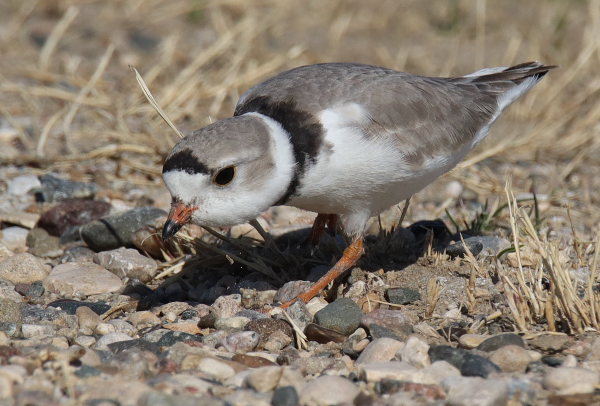
Throughout the photo session, the Piping Plover found bits of food, but it was always facing away as it grabbed a morsel – except this time. The fast shutter speed stopped the action of the plover foraging.
The Piping Plover was not only a very big surprise sighting, and linked with an almost unimaginable chance to reposition to take optimum photos, it was a remarkably rewarding opportunity and a huge thrill. I couldn’t dream this stuff up. I’ve only had a few chances to see and photograph Piping Plovers over the years, and this episode was the best by far. I hope my good luck rubs off on you the next time you take an afternoon photo trip – Good Luck!
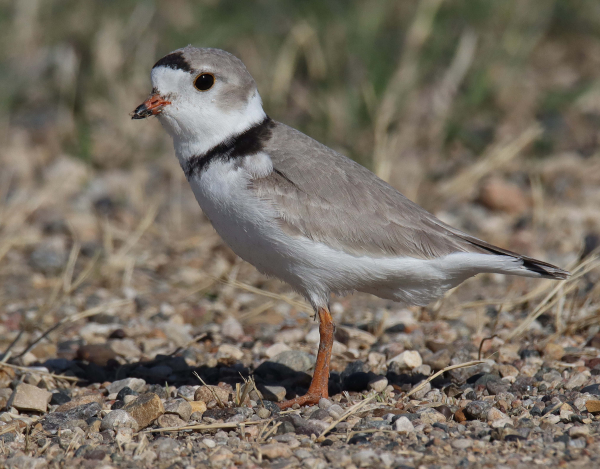
This initial photo taken of the Piping Plover shows a relaxed bird during a pause between foraging movements. We all hope for the chance to take a series of photos of a rarely encountered bird that accepts our attention, and we savor it when the opportunity arises.
Article and photographs by Paul Konrad
Share your bird photos and birding experiences at editorstbw2@gmail.com